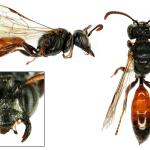Mimesa equestris misident.; Psen rufa PANZER 1805
A small, ground-nesting, red and black solitary wasp. The nomenclature of this species has been the subject of some confusion. Identification keys are given in Yeo & Corbet (1995) (as Psen bicolor); Lomholt (1984) (as Mimesa rufa), and Richards (1980) (as Psen bicolor). Prior to the publication of a paper by Spooner in 1948 the species was referred to as Psen equestris, so care is needed when citing older records of this wasp.
Widely recorded from scattered localities in southern Britain north to south Yorkshire.
Overseas, found widely distributed throughout Europe and Central Asia.
Listed as Rare (RDB3) in Shirt (1987); provisionally upgraded to Vulnerable (RDB2) by Falk (1991). There are very few modern records and so its status may well require further re-evaluation.
Found in a range of open habitats with light soils, such as heathland; occasionally recorded from coastal dunes.
Univoltine; June to September (Falk 1991).
Nest burrows are stocked with a range of small homopteran bugs, usually leafhoppers of the family Cicadellidae. Abroad, the species has also been known to provision cells with plant lice (Psyllidae) (Lomholdt 1984).
Nests are dug in sandy soil in warm, sheltered situations. Nesting sites such as the uncompacted edges of paths are often utilised, the burrows are made in bare ground though the nest site itself may be overhung with vegetation. Nests consist of a single vertical unbranched burrow, 3-8 cm in length. Nesting often occurs in small aggregations.
A wide range of Apiaceae (e.g. wild angelica, carrot, hogweed, wild parsnip) and occasionally thistles.
None recorded from Britain. In Fennoscandia, Lomholt (1984) cites the non-British chrysid wasp Omalus constrictus as a parasite.
2005


